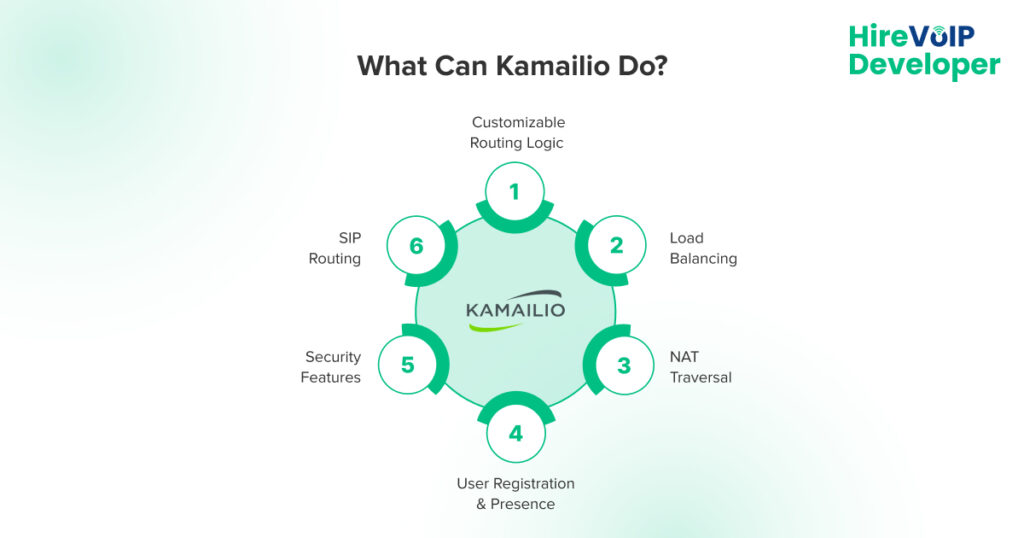📝 Blog Summary
Kamailio is an open-source SIP server trusted by global VoIP providers for its high performance, scalability, and extensive customization options. It routes SIP traffic, manages user registrations, handles NAT traversal, and secures VoIP systems. Ideal for startups to telecom carriers, Kamailio offers robust, cost-effective control over modern voice infrastructure. How? Let’s find out below in the blog.
When I think about the early days of VoIP systems, I remember how difficult and confusing things used to be. Call quality was unstable, systems weren’t flexible, and managing a growing number of calls felt like a daily challenge.
Luckily, we’ve come a long way, and tools like Kamailio are a big reason why.
Let’s talk about what Kamailio VoIP is and why it might be the right solution for your VoIP development.
What Is Kamailio?
Kamailio is a leading open-source SIP (Session Initiation Protocol) server that plays a central role in VoIP (Voice over IP) systems. SIP is the protocol that enables the setup, management, and termination of internet-based phone calls and video sessions.
While Kamailio doesn’t handle the actual voice or video data (that’s the media layer, typically managed by tools like RTPProxy or RTPEngine), it controls how calls are routed, how users register on the network, authenticates sessions, and ensures seamless connectivity even across NATs and firewalls. It also supports presence, load balancing, and other key features needed in modern VoIP setups.
Over the years, Kamailio has grown from a community-driven open-source project into a trusted platform used by telecom providers, ISPs, and enterprises worldwide. Its performance, flexibility, and ability to handle massive volumes of signaling traffic make it ideal for a wide range of applications, from small deployments to carrier-grade environments.
Did You Know?
In stateless or load-balancing modes, Kamailio supports over 5,000 call setups per second, which is ideal for high-load VoIP environments.
This means it can manage massive SIP traffic efficiently, ensuring smooth call routing, low latency, and system stability even during peak usage.
What Can Kamailio Do?
Kamailio SIP server has numerous key features that make it well-suited for handling VoIP traffic. Here are some key functions:

1. SIP Routing:
Kamailio’s core strength lies in its ability to route SIP messages between different users, servers, or networks. It decides the best path for each call setup, ensuring that calls are delivered quickly and reliably without unnecessary delays. This routing flexibility enables businesses to seamlessly connect internal users, branch offices, and external networks, regardless of scale or complexity.
This routing capability also supports advanced scenarios, such as least-cost routing, where calls are directed through the most cost-effective paths, thereby saving businesses money. Kamailio’s routing engine can handle millions of calls per second, making it highly efficient for large VoIP deployments. This ensures your system can keep up even during traffic spikes without dropping calls.
2. Load Balancing:
Kamailio’s load balancing distributes incoming call requests evenly across multiple servers. This prevents any single server from becoming overwhelmed, which could lead to poor call quality or system crashes. Load balancing helps maintain a smooth user experience and keeps your VoIP system highly available and responsive.
Besides preventing overloads, load balancing also supports redundancy. If one server fails, Kamailio can automatically route calls to healthy servers without interruption. This ability makes Kamailio an excellent choice for businesses that require reliable and uninterrupted voice services, even during peak hours or in the event of unexpected technical issues.
3. User Registration and Presence:
Kamailio tracks which users or devices are currently online and ready to receive calls by managing user registrations. This feature is crucial because it enables the system to determine where to direct incoming calls based on who is available at any given time. It works well with softphones, desk phones, or mobile apps connected to the VoIP system.
Beyond registration, Kamailio can monitor a user’s presence status — whether they are online, offline, busy, or away. This presence information can be used to enhance call routing decisions and support advanced features, such as instant messaging or call forwarding. This ensures calls are never missed and users stay connected efficiently.
🚀 Ready to scale your VoIP network with Kamailio? We’ve got your back.
4. NAT Traversal:
Network Address Translation (NAT) routers can cause problems for VoIP calls because they hide internal IP addresses behind a single public IP. Without proper handling, calls might fail to connect or experience poor audio quality. Kamailio includes tools to solve these NAT traversal issues by correctly routing SIP messages through firewalls and routers.
It supports protocols and techniques such as STUN, TURN, and ICE, which help VoIP devices discover their public IP addresses and establish a direct communication path. This capability enables VoIP calls to function seamlessly even in complex network environments, thereby reducing dropped calls and enhancing the user experience, particularly for remote or mobile users.
5. Security Features:
Kamailio provides essential security measures to protect VoIP systems from threats and unauthorized access. It supports TLS (Transport Layer Security) encryption to secure SIP signaling, ensuring that call setup messages cannot be intercepted or tampered with during transmission. This is critical for protecting sensitive business communications.
Additionally, Kamailio handles user authentication to ensure that only authorized devices and users can register and make calls. It also includes mechanisms to detect and prevent common VoIP attacks, such as SIP flooding and toll fraud. By using Kamailio’s security features, businesses can maintain a trusted and safe VoIP environment.
6. Customizable Routing Logic:
One of Kamailio’s most powerful features is its scripting language, which allows you to customize how calls are routed and processed. You can write detailed scripts to define specific call handling rules based on your business logic, such as time-based routing, load-based decisions, or user-specific rules.
This flexibility means Kamailio can adapt to many use cases, whether it’s a simple office phone system or a complex telecom service provider setup. You can also integrate Kamailio with databases, billing systems, or external APIs to automate workflows and enhance the capabilities of your VoIP infrastructure. This customization makes Kamailio a truly versatile SIP server.
Why Kamailio Is a Good Fit for VoIP Infrastructure
1. High Performance
Kamailio is built to handle high traffic efficiently. It can manage thousands of concurrent SIP calls per second, even on basic hardware setups. This means businesses don’t have to invest in expensive equipment to support a growing user base. The efficient architecture allows it to process signaling traffic quickly without delay, ensuring calls connect smoothly.
For businesses that rely on real-time voice communication, this performance is a big plus. Whether it’s internal team calls or customer support lines, Kamailio ensures stability and fast call setup. Even during traffic spikes or peak business hours, the system remains responsive, minimising dropped calls and ensuring continuous service.
2. Scalability
Kamailio is highly scalable, making it a great fit for businesses of any size. You can scale horizontally by deploying multiple Kamailio instances across different servers and locations. This helps balance traffic and create failover setups for better reliability. Alternatively, you can scale vertically by using more powerful machines to handle increased call volume.
As your business expands—whether you’re adding new teams, clients, or locations—Kamailio can grow with you. You don’t have to overhaul the entire VoIP system every time your communication needs increase. Its scalable architecture makes it suitable for startups, mid-sized businesses, or even large telecom carriers handling millions of calls per day.
3. Flexibility
Kamailio is highly flexible and integrates easily with other VoIP tools and platforms, such as Asterisk and FreeSWITCH, and can also be easily configured with OpenSIPS. This allows businesses to create hybrid VoIP setups that combine Kamailio’s strong signaling features with media handling tools or PBX systems. You can also use it for SIP trunking, load balancing, or as a SIP registrar.
Beyond integrations, Kamailio supports scripting for advanced customization. You can define routing logic, billing rules, security policies, or even set time-based call flows. This flexibility means your VoIP system isn’t locked into rigid behavior—you can adapt it to meet your exact technical or business requirements.
4. Security
Security is critical in VoIP systems, and Kamailio comes equipped with several tools to protect your infrastructure. It supports TLS for encrypted SIP signaling and SRTP for secure media streams. This ensures sensitive voice data and call setups are protected from interception or tampering during transmission.
Additionally, Kamailio allows you to set up IP whitelisting, blacklisting, rate limits, and strong authentication methods. These features help block unauthorized access, detect VoIP fraud attempts, and reduce exposure to SIP attacks like floods or spoofing. With Kamailio, your communication system remains stable and secure.
5. Open Source Benefits
Being open source, Kamailio gives businesses full control over their VoIP stack without license fees. You can install it, configure it, and modify the code to fit your needs without paying for commercial software licenses. This makes it especially attractive for startups or companies trying to reduce operational costs.
More importantly, the open-source nature means Kamailio has a large, active community. You get access to frequent updates, bug fixes, and a rich knowledge base of configurations and use cases. Whether you need to scale, secure, or customize your VoIP infrastructure, Kamailio offers the freedom and flexibility to do so without vendor lock-in.
🌐 Unlock the power of Kamailio for enterprise-grade SIP control.
Conclusion
In summary, Kamailio is a powerful, scalable, and flexible solution for modern VoIP infrastructure. Whether you’re a startup exploring VoIP options or a large-scale telecom operator managing millions of calls, Kamailio brings unmatched performance, security, and customization capabilities. From handling high SIP traffic with minimal resources to integrating seamlessly with platforms like Asterisk or FreeSWITCH, Kamailio adapts to your unique communication needs.
Its robust support for SIP routing, load balancing, NAT traversal, and authentication, combined with the freedom of open-source licensing, makes it an ideal choice for businesses looking to build reliable, cost-effective, and secure voice solutions.
Need Kamailio Expertise on Your Side?
With Kamailio, the possibilities are endless, but only if you have the right experts to unlock them. Our dedicated VoIP developers bring deep Kamailio experience to help you. If you’re building from scratch or improving an existing deployment, we bring the technical edge your VoIP project needs.
Let’s Build Something Powerful. Hire Kamailio Developers Today.


